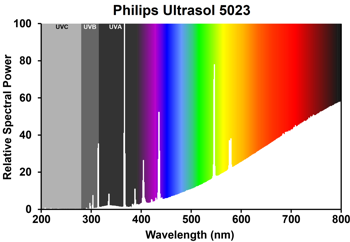
|
Philips Ultrasol 5023 Self-Ballasted Mercury |

At the heart of the lamp is spherical discharge vessel having a pair of offset triple-coil thermionic cathodes, between which an arc-shaped discharge bows upwards such that it is centred within the bulb. A sizeable quantity of mercury is present, the heat of a tungsten filament in the outer bulb causing a large vapour pressure to develop. The filament also acts as an electrical ballast for the discharge.
The spherical arc tube was chosen to elimitate cold crevices where mercury could condense, thereby raising its vapour pressure which is important to increase its efficiency of UV generation. Note the unusual glass-to-metal seals, which each consist of a pair of chrome-iron plates sealed into the sidewall of the glass sphere. An increased arc length is beneficial to raise its voltage and ensure that proportionally more of the mains voltage is dissipated in the discharge rather than the series filament, but too long an electrode gap would raise the ignition voltage above the mains level. This was partly overcome by opting for the spherical tube with short electrode gap, whose arc bows upwards and raises its length and voltage only when hot. Nevertheless, radiometric measurements reveal that this lamp is very inefficient, with about ten times less erythemal power than GE's S-2. As such it was rather quickly discontinued.




| Manufacturer: | N.V. Philips Gloeilampenfabrieken | |
| Lamp Power: | 110 Watts | |
| Lamp Voltage: | 220 Volts | |
| Lamp Current: | 0.505 Amps | |
| Cap Type: | E27s | Skirted Nickel Plated Brass |
| Bulb Type: | S-65 | S-20½ (in eighths/inch) |
| Bulb Finish: | Clear soft glass | Transmitting to 280nm |
| Electrodes: | C-9 filament | Tungsten single coil |
| Atmosphere: | Inner: Hg | NeAr | Outer: Nitrogen |
| Luminous Flux: | 800 lm | |
| Luminous Efficacy: | 6.8 lm/W | |
| Radiant Flux: | UV-A 0.17W, UV-B 0.05W | Visible 6.1W |
| Colour Temperature & CRI: | CCT: 2925K | CRI: Ra93 |
| Chromaticity Co-ordinates: | CCx: 0.440 | CCy: 0.415 |
| Rated Life: | Unknown | |
| Warm Up / Re-strike Time: | Approx. 10 minutes | Approx. 5 minutes |
| Burning Position: | Vertical base up | |
| Overall Length: | 180 mm | 71/8 inches |
| Light Centre Length: | 120 mm | 43/4 inches |
| Factory: | Eindhoven NatLab | The Netherlands |
| Date of Manufacture: | 1935 Week 43 | Date Code: A43 |
| Original Value: | Hƒℓ 13.50 (1933) | |

